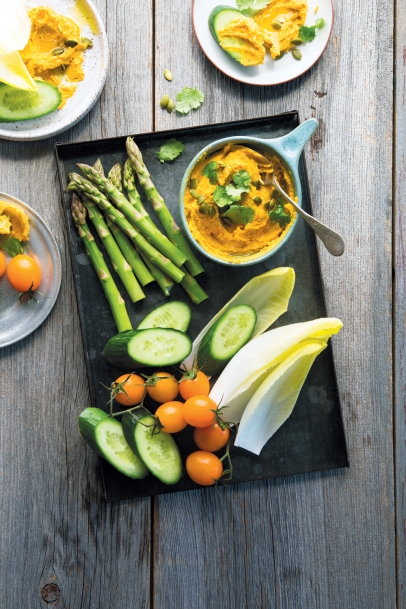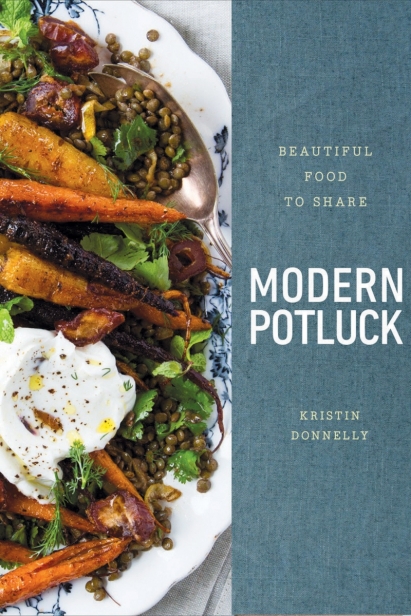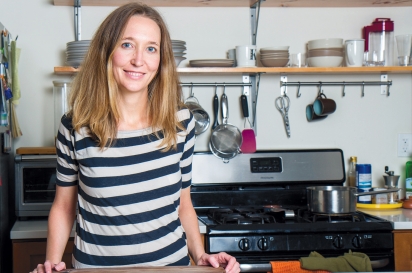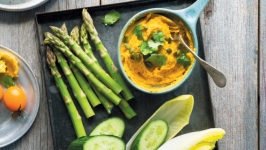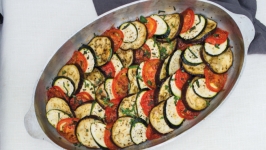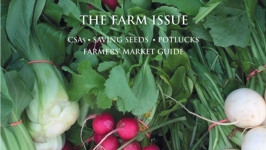Today's Potluck
A new book offers a farm-fresh update for an American entertaining tradition
Carrots are just different at the farmers’ market.
The supermarket produce section is a showplace of order, its carrots all the same shade of orange, each a uniform length, counted out, bagged in plastic, and stacked neatly. At the farmers’ market, though, they could be a different vegetable altogether: Scattered in wicker baskets, they look as varied as a painter’s palette in shades of purple, red, orange and yellow. Their shapes, too, change—short and long, some with two or three legs, long root ends snaking out past the tip.
A pile of these glorious, strange roots, roasted with spices, herbs, dates, and lentils and topped with a dollop of yogurt, graces the cover of Kristin Donnelly’s new cookbook Modern Potluck (Clarkson Potter). The dish is vegetarian, gluten-free, and utterly alluring, full of contrasting textures, rich flavors, and umami. Many of the book’s recipes are best made with this kind of heirloom or peak-season produce—the stuff you’ll find at farmers’ markets now through the end of November.
Potluck dishes based on vibrant local produce are a far cry from the bland tuna casseroles and goopy macaroni salads that the word potluck often brings to mind—and that’s precisely the point, Donnelly says. “Potlucks have a fusty image, while other culinary spaces have really evolved.”
Donnelly is a Philadelphia native who moved to New York to attend culinary school. She worked in wine shops for a while, and that work connected her to an editor for Food & Wine magazine—a lucky break that led her into a career as a food writer and editor. She recently returned to Pennsylvania, settling in New Hope, where she now works as a freelance writer and recipe developer.
Potlucks were a beloved part of Donnelly’s family life growing up, but she left them behind when she left Pennsylvania, instead favoring restaurants and formal dinner parties—until she had a baby four years ago. Like most new parents, her life was high on mess and stress and low on free time for socializing or whipping up complicated dishes. “Kids change your social life significantly,” she says. The labor of hosting a dinner party became more stressful than fun. She needed a casual, low-pressure way to reconnect with friends. That was when she rediscovered the potluck.
When she began throwing potlucks, though, Donnelly realized that the way the American public eats had changed in the years since her childhood. “In an era of artisan pickles, gluten-free diets, #foodporn hashtags, pastured eggs, and kimchi tacos, the potluck has become potentially quite complicated,” she writes. There’s social pressure “to make a standout dish to serve people who are way savvier about food than they were a few decades ago.” Health, sustainability and restricted diets all factor into cooks’ calculations about what to bring to a potluck in a way they didn’t just one generation back. A dish needs to look good, taste good and cater to the needs and sensibilities of guests.
Working at the heart of the culinary world exposed Donnelly to a wide range of international cuisines, techniques and flavor profiles. It also put her in touch with the needs and desires of home cooks—and her consideration is clear in the pages of Modern Potluck. The dishes, which range from full entrées to appetizers, salads, desserts, and even cocktails, draw from food traditions across the globe, but few of them could be considered “traditional” or even limited to a single culture.
Donnelly’s Scandinavian-inspired Aquavit-cured salmon sits comfortably next to a roasted carrot and curry hummus and a Moroccan-inspired shepherd’s pie. Ingredients as diverse as harissa, furikake, and kimchi lend sophistication. The result is food that’s “definitely more boldly flavored than traditional potluck food, but not too out there,” Donnelly says. “Just a hint of edge” makes dishes appeal to guests’ sense of adventure without scaring them away. Offering foods that are accessible to guests is important, too.
Donnelly recommends asking beforehand whether food intolerances are a concern, and labeling dishes that contain allergens like nuts and dairy or other ingredients guests might want to avoid, like gluten, heavy spices or meat. Since dietary restrictions can often trip up cooks who aren’t experienced with them, a significant portion of Modern Potluck’s recipes are vegetarian, vegan, or gluten-free or can be modified easily.
The recipes themselves vary in their level of difficulty from quick and easy to complex. “Cooking from scratch, especially dishes like casseroles, can be time-consuming,” Donnelly says. “One nice thing about making one dish instead of a full multi-course dinner party is that you can put more time and effort into that dish.” Some of her recipes are fairly elaborate, while others—like the ones in the sections on crudités and deviled eggs—are simple preparations intended to showcase the flavors of farmers’-market vegetables and high-quality ingredients. All are designed to hold up well on a buffet table, to scale up or down depending on the size of the crowd, and to be simple to set up and serve.
Modern Potluck offers cooks some potluck-specific tips as well, with notes on how to pack dishes for travel to a party—and how to make them stand out on the buffet table. “If you can add a little extra flourish through a garnish or a sauce, that does make people stop and try it,” Donnelly says. Since even the humble potluck tends to be Instagrammed these days, she developed her recipes with an eye for presentation that she honed in the magazine world.
Fortunately, ingredients like those colorful farmers’-market carrots make beautiful presentations easy. You don’t need to fuss around trying to construct origami shapes out of puff pastry—just get some gorgeous, fresh ingredients and let them speak for themselves. Donnelly’s recipe for radishes with seaweed-sesame butter and smoked salt, for example, is simplicity itself: good radishes, served with a flavorful compound butter for dipping.
Access to quality produce was part of what brought Donnelly and her husband to New Hope. “It was really important to us to have access to good ingredients. Stockton, New Jersey, just a few minutes away from us, has a great weekend market,” she says. A friend works for Blue Moon Acres in Pennington, she adds, “and they have exquisite produce.”
Potlucks can be as large or as small as you like, with a little organization or a lot, but Donnelly offers some guidelines to make everything run smoothly. She recommends that hosts think about how people will flow through the room and organize accordingly—grouping dishes by course, perhaps, or putting all of the gluten-free food on a separate table for easy access. Preheating your oven and having trivets and potholders on hand will help with hot dishes, and providing pens and index cards makes it easy for guests to label their contributions.
Perhaps the most important aspect of the potluck, Donnelly says, is to relax and let your friends or family—your community—shoulder the burden of cooking and hosting. “It’s another way to bring people around a table, while sharing some of the labor involved.” That makes potlucks especially helpful for people who might not otherwise be able to host or attend an event—giving not just new parents but people with disabilities or health concerns, people who work long hours or don’t have access to a full kitchen, and many others access to a full and vibrant social life.
The way we cook and the way we eat have changed—but the potluck is still going strong. With its updated take on this American tradition, Modern Potluck will have new and experienced cooks alike rushing to the nearest farm stand to recreate its fresh and vibrant dishes and share them with friends.
RECIPES
ROASTED CARROT AND CURRY HUMMUS
ANNA’S SUMMER VEGETABLE TIAN
KRISTIN DONNELLY’S RULES FOR THE MODERN POTLUCK
1) Consider picking a theme. “Global street food” leaves lots of possibilities open; a wine-pairing theme would ask guests to bring a dish and wine that pairs well with it.
2) Label foods, and tell guests about any dietary restrictions. If anything is a must (for instance, absolutely no peanut products), be clear about that beforehand.
3) Put some feng shui in your buffet. Think about how guests will flow through the room and the meal, and arrange the dishes accordingly—for instance, with desserts on a separate table.
4) Get your kitchen guest-ready. Turn the oven on low before people arrive, in case dishes need to be warmed. Clear counters and outlets as much as possible to allow room for last-minute preparations.
5) Better safe than salmonella. Keep hot foods hot and cold foods cold, and keep an eye on them, especially in hot weather. Clean anything that touches raw or partially cooked meat, seafood or poultry immediately to avoid cross-contamination.
6) Don’t forget about serving tools. Utensils, plates, napkins and cups are the host’s responsibility, unless you delegate it, so have them on hand. Extra serving spoons and dishes often come in handy, too.
7) Remember the kids. If you’ll have some young guests, ensure that at least a few dishes and drinks are kid-friendly.
8) Stock the bar. Whether or not your guests are drinking alcohol, have some tasty nonalcoholic options on hand. Put ice, coolers, water, and wine and beer openers in the drinks area to avoid making people search for them.
9) Know the terrain. If the potluck isn’t at your home, find out what will be on hand at your party site: Are there grills? Bathrooms? Garbage cans? You don’t want any last-minute surprises.
10) Relax. Feel free to organize who’s bringing what, but control your inner control freak. Potlucks are supposed to be a patchwork. It’s all part of the fun.


